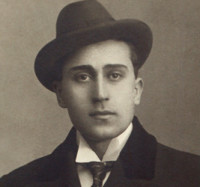
Hamo Beknazaryan
Born May 31, 1892 in Yerevan. In 1912 got admitted to the Moscow University, Faculty of Law. In 1913 he transferred to Moscow Commercial Institute which he graduated in 1918. In 1914 he began appearing in movies and shortly after became a popular actor of pre-revolutionary Russian cinema.
In 1921 along with German Gogetidze Beknazaryan founded the Film Department adjacent to the Georgian People’s Commissariat of Enlightenment. In 1923 the Film Department was reformed and became Georgia’s State Film Production Company. Beknazaryan was its first chairman and artistic director. The same year he made his film debut with Patricide. Later he made two more films in Georgia – The Lost Treasure (1924) and Natella (1925).
In 1925 the Committee of People’s Commissars of Armenia invited Beknazaryan to make the first Armenian feature film Namus. In 1926 Beknazaryan moved to Yerevan and continued to be the artistic director of the “Armenfilm” studio up until 1951.
In 1926 Beknazaryan made the very first film in history about the Yazidi people called Zare. The same year he also wrote and directed the first Armenian comedy film Shor and Shorshor. Also that year after the devastating earthquake in the city of Leninakan, Beknazaryan went to the place of the event along with cameraman Arkady Yalovoy. As a result the documentary film The Earthquake in Leninakan was born. Later on Beknazaryan made several documentaries including Leather, Cotton (both in 1927), Land of Nairi (1930), Soviet Armenia (1950). In 1927 he made the epic film Khaspush about the 1895 uprising of the Persian lumpenproletariat. The 1928 film House on a Volcano was about the struggles of the multinational Baku proletariat. In 1935 Beknazaryan directed the first Armenian sound film Pepo (music by Aram Khachaturyan).
In 1927 at the initiative of Beknazaryan a studio called “Vostokfilm” (East film) was founded in Moscow, which was specifically designed to produce films about the smaller nations of the USSR. In 1930-1931 Beknazaryan made two films for the studio about the life of the Nanai people – the feature film Igdembu and the documentary The Land of Golds. He also made the feature film The Man with the Medal about the everyday life of the Chechen people. The depiction of life and culture of various (especially smaller) nations is quite typical of Beknazaryan.
He spent his last years in Moscow. Not long before his death he completed writing his autobiography Notes of an Actor and a Director, which was published post-mortem. Beknazaryan died April 27, 1965. In many respects, Hamo Beknazaryan’s body of work predetermined the further evolution of Armenian cinema, its particular artistic qualities and distinctive features.

 Հայերեն
Հայերեն